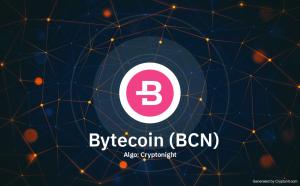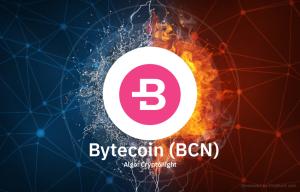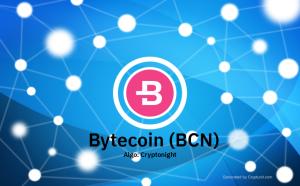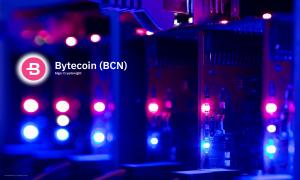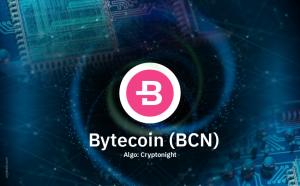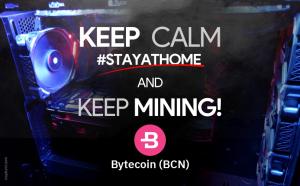Bytecoin (BCN)
$0.000027
(-5% )
0.00000000 BTC
0.046 Mh/s
Hashrate
$0.22
0.0000026 BTC
1.35 BCN
Last reward
4/1
Miners/Pools
| POOL MINING | DAY Current Diff |
DAY 1h AVG Diff |
DAY 24h AVG Diff |
WEEK 24h AVG Diff |
MONTH 24h AVG Diff |
|
|---|---|---|---|---|---|---|
| Rewards BCN | 42.3 | 42.3 | 42.3 | 296 | 1,268 | |
| Revenue BTC | 0.00000001 | 0.00000001 | 0.00000001 | 0.00000009 | 0.00000038 | |
| Revenue USD | $0.0011 | $0.0011 | $0.0012 | $0.0084 | $0.036 |
Bytecoin mining pools
| Pool Name | Merged | Fee % | Min Pay | Miners | Mh/s | Status | ||
|---|---|---|---|---|---|---|---|---|
| Fairhash | 1 | 200 | 4 | 0.12 | 10 min ago |
Bytecoin markets
Bytecoin
Bytecoin is the first CryptoNote-based currency, which has reached mass adoption successfully. Bytecoin also possesses one of the largest ecosystems. Bytecoin has been originally created in close cooperation with CryptoNote team. It is the first implementation of CryptoNote technology, with the release dating back to July 2012. Up to this date Bytecoin developers has been making significant contributions to the development of CryptoNote technology.
| Ticker | BCN |
| Announced | Jun 2011 |
| Forked from | Originally |
| Hashing algo | CN ASIC |
| Block time | 120 sec |
| Decimal places | 8 |
| Last reward | 1.35 |
| Current height | 3,467,879 |
| Historical data | JSON |
| CN | 07. Feb 2018 |
| Jan 2021 | |
| Mar 2020 | |
| Feb 2018 | |
| Feb 2018 | |
| Feb 2018 | |
| Feb 2018 | |
| Feb 2018 | |
| Jan 2018 | |
| Dec 2017 | |
| Oct 2017 | |
| Sep 2017 | |
| Aug 2017 | |
| Jul 2017 | |
| Jun 2017 | |
| Oct 2016 | |
| Dec 2015 | |
| Jun 2014 | |
| Apr 2014 |
Ticker: BCN
Total coins: 18 446 744 073 709 551 616 atomic units (= 184.46 billion BCN)
Block time: 120 seconds (2 minutes)
Difficulty retargets each block
Block reward decreases each block according to the formula: BaseReward = (MSupply - A)/218, where MSupply = (264 - 1) atomic units and 'A' is amount of already generated coins
One coin is divisible down to 8 decimal places (divisible up to 108)
What is Bytecoin?
Bytecoin is a private, decentralized cryptocurrency with an open source code that allows everyone to take part in the network development of Bytecoin. Privacy and security are naturally proponents of Bytecoin and it’s best solution for those who want to keep their finances private.
Technology
Untraceable payments
The ordinary digital signature (e.g. (EC)DSA, Schnorr, etc...) verification process involves the public key of the signer. It is a necessary condition, because the signature actually proves that the author possesses the corresponding secret key. But it is not always a sufficient condition.
Ring signature [1] is a more sophisticated scheme, which in fact may demand several different public keys for verification. In the case of ring signature, we have a group of individuals, each with their own secret and public key. The statement proved by ring signatures is that the signer of a given message is a member of the group. The main distinction with the ordinary digital signature schemes is that the signer needs a single secret key, but a verifier cannot establish the exact identity of the signer. Therefore, if you encounter a ring signature with the public keys of Alice, Bob and Carol, you can only claim that one of these individuals was the signer but you will not be able to pinpoint him or her.
This concept can be used to make digital transactions sent to the network untraceable by using the public keys of other members in the ring signature one will apply to the transaction. This approach proves that the creator of the transaction is eligible to spend the amount specified in the transaction but his identity will be indistinguishable from the users whose public keys he used in his ring signatures.
Unlinkable transactions
Normally, when you post your public address, anyone can check all your incoming transactions even if they are hidden behind a ring signature. To avoid linking you can create hundreds of keys and send them to your payers privately, but that deprives you of the convenience of having a single public address.
CryptoNote solves this dilemma by an automatic creation of multiple unique one-time keys, derived from the single public key, for each P2P payment. The solution lies in a clever modification of the Diffie-Hellman exchange protocol [2]. Originally it allows two parties to produce a common secret key derived from their public keys. In our version the sender uses the receiver's public address and his own random data to compute a one-time key for the payment.
The sender can produce only the public part of the key, whereas only the receiver can compute the private part; hence the receiver is the only one who can release the funds after the transaction is committed. He only needs to perform a single-formula check on each transactions to establish if it belongs to him. This process involves his private key, therefore no third party can perform this check and discover the link between the one-time key generated by the sender and the receiver's unique public address.
An important part of our protocol is usage of random data by the sender. It always results in a different one-time key even if the sender and the receiver both remain the same for all transactions (that is why the key is called "one-time"). Moreover, even if they are both the same person, all the one-time keys will also be absolutely unique.
Double-spending proof
Fully anonymous signatures would allow spending the same funds many times which, of course, is incompatible with any payment system's principles. The problem can be fixed as follows.
A ring signature is actually a class of crypto-algorithms with different features. The one CryptoNote uses is the modified version of the "Traceable ring signature" [3]. In fact we transformed traceability into linkability. This property restricts a signer's anonymity as follows: if he creates more than one ring signature using the same private key (the set of foreign public keys is irrelevant), these signatures will be linked together which indicates a double-spending attempt.
To support linkability CryptoNote introduced a special marker being created by a user while signing, which we called a key image. It is the value of a cryptographic one-way function of the secret key, so in math terms it is actually an image of this key. One-wayness means that given only the key image it is impossible to recover the private key. On the other hand, it is computationally impossible to find a collision (two different private keys, which have the same image). Using any formula, except for the specified one, will result in an unverifiable signature. All things considered, the key image is unavoidable, unambiguous and yet an anonymous marker of the private key.
Blockchain analysis resistance
There are many academic papers dedicated to the analysis of the Bitcoin's blockchain. Their authors trace the money flow, identify the owners of coins, determine wallet balances and so on. The ability to make such analysis is due to the fact that all the transfers between addresses are transparent: every input in a transaction refers to a unique output. Moreover, users often re-use their old addresses, receiving and sending coins from them many times, which simplifies the analyst's work. It happens unintentionally: if you have a public address (for example, for donations), you are sure to use this address in many inputs and transactions.
CryptoNote is designed to mitigate the risks associated with key re-usage and one-input-to-one-output tracing. Every address for a payment is a unique one-time key, derived from both the sender's and the recipient's data. It can appear twice with a probability of a 256-bit hash collision. As soon as you use a ring signature in your input, it entails the uncertainty: which output has just been spent?
Trying to draw a graph with addresses in the vertices and transactions on the edges, one will get a tree: a graph without any cycles (because no key/address was used twice). Moreover, there are billions of possible graphs, since every ring signature produces ambiguity. Thus, you can't be certain from which possible sender the transaction-edge comes to the address-vertice. Depending on the size of the ring you will guess from "one out of two" to "one out of a thousand". Every next transaction increases the entropy and creates additional obstacles for an analyst.
Adaptive limits
A decentralized payment system must not depend on a single person's decisions, even if this person is a core developer. Hard constants and magic numbers in the code deter the system's evolution and therefore should be eliminated (or at least be cut down to the minimum). Every crucial limit (like max block size or min fee amount) should be re-calculated based on the system's previous state. Therefore, it always changes adaptively and independently, allowing the network to develop on it's own.
CryptoNote has the following parameters which adjust automatically for each new block:
1) Difficulty. The general idea of our algorithm is to sum all the work that nodes have performed during the last 720 blocks and divide it by the time they have spent to accomplish it. The measure of the work is the corresponding difficulty value for each of the blocks. The time is calculated as follows: sort all the 720 timestamps and cut-off 20% of the outliers. The range of the rest 600 values is the time which was spent for 80% of the corresponding blocks.
2) Max block size. Let MN be the median value of the last N blocks sizes. Then the "hard-limit" for the size of accepting blocks is 2*MN. It averts blockchain bloating but still allows the limit to slowly grow with the time if necessary. Transaction size does not need to be limited explicitly. It is bounded by the size of the block.
Smooth emission
The upper bound for the overall amount of all digital coins is also digital:
MSupply = 264 − 1 atomic units
This is a natural restriction based only on the implementation limits, not on intuition like "N coins ought to be enough for everybody". To make the emission process smoother CryptoNote uses the following formula for block rewards:
BaseReward = (MSupply − A) >> 18
where A is amount of previously generated coins. It gives a predictable growth of the money supply without any breakpoints.
[1] Ronald L. Rivest, Adi Shamir, and Yael Tauman. How to leak a secret. In ASIACRYPT, pages 552–565, 2001
[2] Whitfield Diffie and Martin Hellman. New directions in cryptography. IEEE Transactions on Information Theory 22 (6): 644–654, 1976.
[3] Eiichiro Fujisaki and Koutarou Suzuki. Traceable ring signature. In Public Key Cryptography, pages 181–200, 2007.
BCN Wallpapers, Banners, Covers
Recommended BCN Software
TOP BCN Mining Devices
| 248,000 h/s | |
| 240,000 h/s | |
| 240,000 h/s | |
| 220,000 h/s | |
| 160,000 h/s | |
| 124,000 h/s |
Bytecoin Wallets
| Mobile | |
| Desktop | |
| WEB | |
| Paper | |
| WEB, Mobile |
BCN Widgets for your website
 BCN Hiscores!
BCN Hiscores!
| 1 |
Slogger
Privacy Defense |
|
505 |
| 2 |
Asichater
Privacy Defense |
|
145 |
| 3 |
Asichater
Privacy Defense |
|
145 |
| 4 |
Slogger
Privacy Defense |
|
134 |
| 5 |
m2pool
Privacy Defense |
|
98 |

Similar by Hashing algo
| 0 Mh/s | |
| 0 Mh/s | |
| 0 Mh/s | |
| 0 Mh/s | |
| 0 Mh/s |
 CryptUnit
CryptUnit
